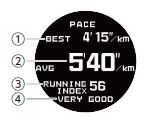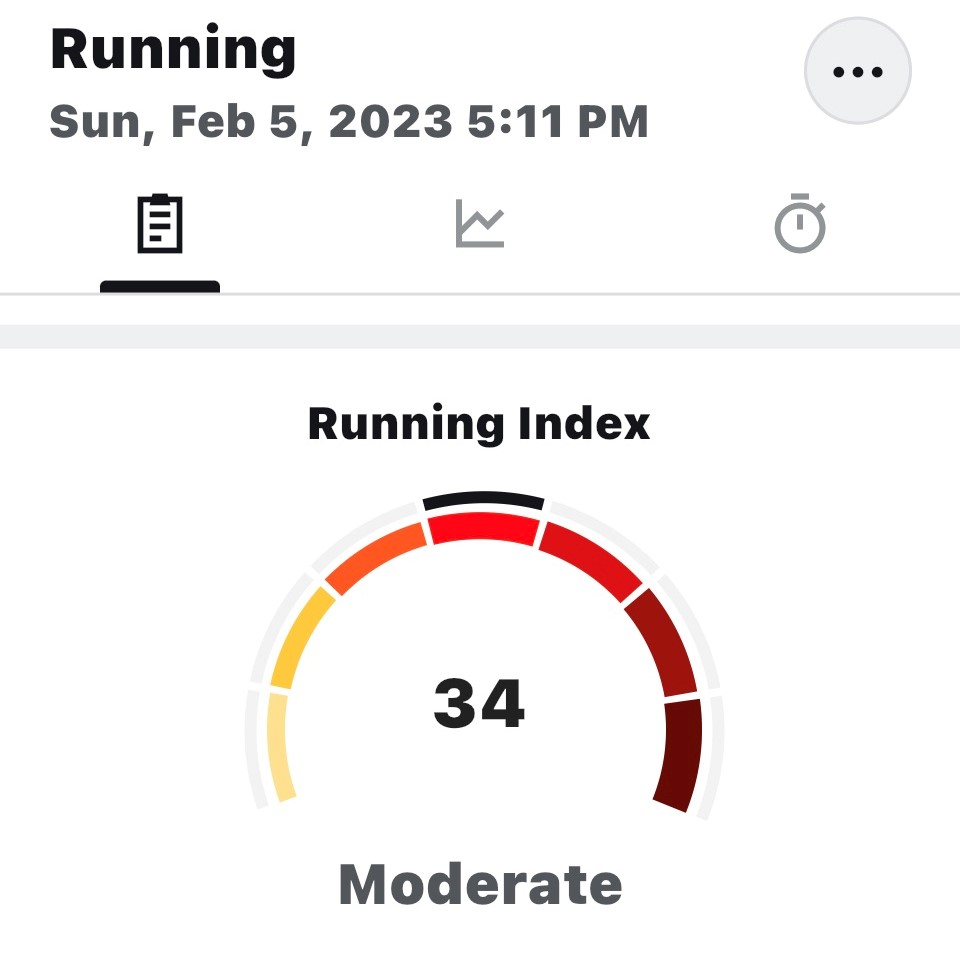
RUNNING INDEX
What is Running Index?
If you’re looking to keep on top of your running performance you’ll find this feature a big help. Regular use over time allows you to see how efficient your running is. Your Running Index score is calculated automatically after every run, based on your heart rate and from the speed data collected via GPS or stride sensor. A higher reading indicates that you can run faster with less effort.
Running Index gives you valuable information about your maximal aerobic running performance. The calculation is based on heart rate and speed data measured during a run. It's calculated every time you do a running exercise that's longer than 12 minutes, where heart rate is recorded and your speed remains above 6 km/h / 3.7 mph.
Why should I be interested in my Running Index?
Whether you’re training for a specific goal or just running to keep fit and healthy, seeing progress is usually what keeps us motivated.
You may also find it interesting to compare your Running Index value to gender and age related aerobic fitness norms. At a population level, aerobic fitness declines with aging, and men generally speaking have better physical attributes for running than women. Comparing your Running Index value with others will give you an idea of your own running fitness level – whether you’re fitter than average in your age group, or if you have some work cut out for you.
How is Running Index calculated?
Calculation begins when you start recording and you have the necessary GPS or Stride sensors in use. The prerequisites for calculation are that your speed remains above 6 km/h and that the run lasts for at least 12 minutes. Although speed is a prerequisite for the calculation, the algorithm does however take natural, unavoidable pauses in your run into consideration. It allows you to stop running or slow down for a minute twice during training, in traffic lights, for example, without disturbing the calculation.
How do I analyze my Running Index?
Before you start analyzing your progress, make sure you have set your maximum heart rate and resting heart rate values in the Flow web service to get as accurate analysis of your performance as possible.
To compare your running fitness with people of the same age and gender, you can use the following chart.
Men
| Age / Years | Very low | Low | Fair | Moderate | Good | Very good | Elite |
| 20-24 | < 32 | 32-37 | 38-43 | 44-50 | 51-56 | 57-62 | > 62 |
| 25-29 | < 31 | 31-35 | 36-42 | 43-48 | 49-53 | 54-59 | > 59 |
| 30-34 | < 29 | 29-34 | 35-40 | 41-45 | 46-51 | 52-56 | > 56 |
| 35-39 | < 28 | 28-32 | 33-38 | 39-43 | 44-48 | 49-54 | > 54 |
| 40-44 | < 26 | 26-31 | 32-35 | 36-41 | 42-46 | 47-51 | > 51 |
| 45-49 | < 25 | 25-29 | 30-34 | 35-39 | 40-43 | 44-48 | > 48 |
| 50-54 | < 24 | 24-27 | 28-32 | 33-36 | 37-41 | 42-46 | > 46 |
| 55-59 | < 22 | 22-26 | 27-30 | 31-34 | 35-39 | 40-43 | > 43 |
| 60-65 | < 21 | 21-24 | 25-28 | 29-32 | 33-36 | 37-40 | > 40 |
Women
| Age / Years | Very low | Low | Fair | Moderate | Good | Very good | Elite |
| 20-24 | < 27 | 27-31 | 32-36 | 37-41 | 42-46 | 47-51 | > 51 |
| 25-29 | < 26 | 26-30 | 31-35 | 36-40 | 41-44 | 45-49 | > 49 |
| 30-34 | < 25 | 25-29 | 30-33 | 34-37 | 38-42 | 43-46 | > 46 |
| 35-39 | < 24 | 24-27 | 28-31 | 32-35 | 36-40 | 41-44 | > 44 |
| 40-44 | < 22 | 22-25 | 26-29 | 30-33 | 34-37 | 38-41 | > 41 |
| 45-49 | < 21 | 21-23 | 24-27 | 28-31 | 32-35 | 36-38 | > 38 |
| 50-54 | < 19 | 19-22 | 23-25 | 26-29 | 30-32 | 33-36 | > 36 |
| 55-59 | < 18 | 18-20 | 21-23 | 24-27 | 28-30 | 31-33 | > 33 |
| 60-65 | < 16 | 16-18 | 19-21 | 22-24 | 25-27 | 28-30 | > 30 |

① Bast pace
② Average pace
③ Running Index
④ Running Index Evaluation

The classification is based on a study by Shvartz & Reibold (1990). Laboratory measured VO2max values have been collected from adults in USA, Canada and 7 European countries.
How do I use Running Index in my training?
Running Index factors together maximal oxygen uptake (VO2max) and running economy and it’s a good predictor of race performance in endurance running. You can use it to predict how fast you could run, for example, a distance of 5K or 10K.
Although you can quite reliably predict your performance using Running Index, you should not forget the importance of other factors such as good preparation, optimal running conditions, and determination - we are all human after all.
Scientific background
Maximal aerobic running fitness is typically measured during a graded exercise test until the voluntary maximum is reached. Special equipment is used to measure oxygen uptake based on inhaled and exhaled air. During the graded exercise test, maximal oxygen uptake (VO2max) is reached when oxygen uptake no longer increases with increasing exercise intensity. Maximal aerobic running speed refers to the running speed at which VO2max occurs.
Running Index applies the essentially linear relationship between heart rate and oxygen uptake during increasing running speed at submaximal speeds. When both resting heart rate and maximal heart rate are known, maximal aerobic running performance can be estimated based on heart rate and speed measured during exercise.
The relationship between running speed and heart rate changes when you gain or lose fitness. When you gain fitness, your heart rate typically decreases at any given submaximal speed, and similarly when you lose fitness, your heart rate typically increases at any given submaximal speed. Running Index takes advantage of this well-known phenomenon and allows you to easily monitor changes in your running performance
Source: Polar Research
Polar science
